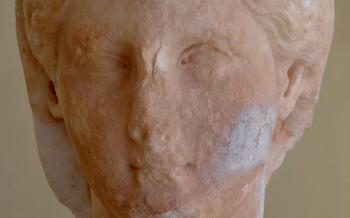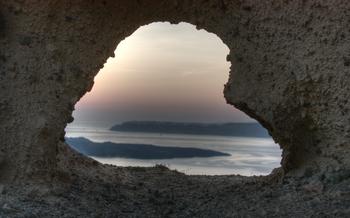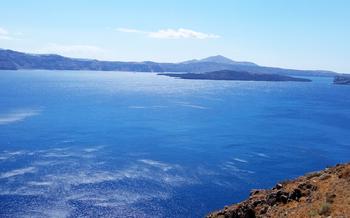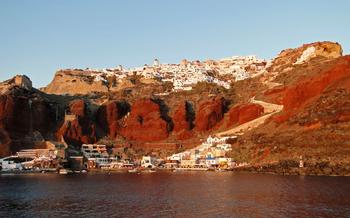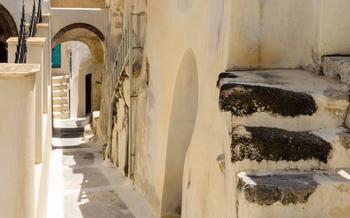
Ancient Thira
- Unveiling the Ancient Wonder: A Journey to Ancient Thira
- Exploring the Ruins of Ancient Thira: A Walk Through Time
- The Theatre of Ancient Thira: A Stage for Drama and Spectacle
- The Temple of Apollo: A Sacred Site Dedicated to the Sun God
- The Agora: The Heart of Ancient Thira's Public Life
- The Necropolis: A Journey into the Afterlife
- The Hike to Ancient Thira: A Scenic Adventure
- Best Time to Visit Ancient Thira: Avoiding the Crowds
- Guided Tours: Enhancing Your Experience
- Photography Enthusiasts: Capturing Ancient Thira's Beauty
- Insider Tip: Unforgettable Sunset Views
Unveiling the Ancient Wonder: A Journey to Ancient Thira
Historical significance of Ancient Thira
Nestled on the majestic Mesa Vouno mountain, Ancient Thira stands as a testament to the rich history of Santorini. It was founded in the 9th century BC by Dorian colonists from Sparta and remained a thriving city-state for over a thousand years. Ancient Thira played a crucial role in the maritime trade of the Aegean Sea and was renowned for its wealth and cultural achievements.
Location and accessibility
Ancient Thira is located in the southeastern part of Santorini, approximately 10 kilometers from the modern capital, Fira. The ruins are easily accessible by car or bus, and the journey offers breathtaking views of the island's stunning caldera. Once you reach the foot of Mesa Vouno, a scenic footpath leads to the ancient city, providing an immersive experience as you step back in time.
Must-see landmarks and ruins
As you explore Ancient Thira, you'll encounter a treasure trove of well-preserved ruins that offer a glimpse into the city's glorious past. The impressive fortifications, constructed of massive stone blocks, once protected the city from invaders. The Agora, the bustling marketplace, still retains its original layout and features shops, temples, and public buildings. The Odeon, a small theater, hosted musical performances and gatherings. And don't miss the awe-inspiring Temple of Apollo, dedicated to the revered sun god, with its majestic columns and intricate carvings.
Exploring the Ruins of Ancient Thira: A Walk Through Time
A journey through the ruins of Ancient Thira unveils the fascinating remains of the ancient city's buildings, offering a glimpse into the architectural prowess and urban planning of the past. Among these ruins, visitors can admire the well-preserved foundations of houses, shops, and public buildings, providing a tangible connection to the daily lives of the ancient inhabitants. Unique architectural features such as cisterns, drainage systems, and intricate staircases showcase the ingenuity and engineering skills of the ancient Thiraians. Stroll along the ancient streets and imagine the bustling atmosphere of a once-thriving city, where people went about their daily routines, engaged in trade, and celebrated religious festivals. The ruins of Ancient Thira stand as a testament to the enduring legacy of this ancient civilization, inviting visitors to step back in time and experience the grandeur of a bygone era.
The Theatre of Ancient Thira: A Stage for Drama and Spectacle
Carved into the hillside of Ancient Thira, the theatre stands as a testament to the city's cultural and artistic heritage. Constructed in the 3rd century BC, this impressive structure boasts remarkable architectural features that reflect the ingenuity of ancient Greek architects. The theatre's well-preserved stone seating, arranged in tiers, offers a panoramic view of the Aegean Sea, creating a breathtaking backdrop for performances.
The theatre's stage, once adorned with intricate Bühnenbilder, hosted a variety of performances, including theatrical plays, musical concerts, and religious ceremonies. The acoustics are exceptional, allowing the actors' voices to carry throughout the auditorium, ensuring that every spectator could fully immerse themselves in the performances.
Attending a performance at the Ancient Thira theatre would have been a significant social and cultural event for the inhabitants of the city. It was a place where they could come together to celebrate their shared heritage, enjoy the arts, and engage in lively discussions about the topics explored in the performances.
The Temple of Apollo: A Sacred Site Dedicated to the Sun God
Among the ruins of Ancient Thira, the Temple of Apollo stands as a testament to the city's religious devotion and architectural prowess. Dedicated to the revered sun god Apollo, this sacred site holds immense historical and religious significance.
Constructed in the 7th century BC, the temple served as a focal point for religious rituals and ceremonies honoring Apollo, the patron deity of music, poetry, and prophecy. The temple's impressive Doric columns, intricately carved pediments, and well-preserved foundations showcase the exceptional craftsmanship of ancient Greek builders.
Within the temple's sacred precincts, visitors can admire the remains of the altar where offerings were made to Apollo. The temple's orientation, facing directly east, allowed the first rays of the rising sun to illuminate the altar, creating a mesmerizing spectacle that symbolized the god's radiant power.
Excavations at the site have unearthed a wealth of artifacts, including pottery, sculptures, and inscriptions, providing valuable insights into the religious practices and beliefs of Ancient Thira's inhabitants. These artifacts are now housed in the Museum of Ancient Thira, offering visitors a deeper understanding of the temple's history and significance.
The Agora: The Heart of Ancient Thira's Public Life
The agora, located in the center of Ancient Thira, served as the bustling hub of public life and commerce. This central square was not merely a marketplace but also a gathering place for citizens to engage in social, political, and religious activities.
Similar to other ancient Greek cities, the agora in Thira was laid out in a rectangular or square shape, surrounded by stoas or colonnaded walkways. These stoas provided shelter from the sun and rain and housed shops, workshops, and other businesses.
The agora was the heart of the city's economic activity. Merchants from all over the region would gather here to trade goods, from agricultural products to imported luxuries. The marketplace was also a place for locals to buy and sell everyday necessities, such as food, clothing, and household items.
In addition to its commercial function, the agora served as a social and political center. Citizens would gather here to discuss important issues, hold assemblies, and make decisions that affected the city's governance. The agora was also the site of religious festivals and celebrations, where people would come together to honor their gods and goddesses.
Overall, the agora was a vibrant and dynamic space that reflected the diverse aspects of ancient Thiran society. It was a place where people could trade, socialize, conduct business, and participate in civic life.
The Necropolis: A Journey into the Afterlife
Ancient Thira's necropolis, located on the outskirts of the city, offers a glimpse into the beliefs and funerary practices of its ancient inhabitants. This vast burial ground holds a variety of tombs, ranging from simple rock-cut graves to elaborate chamber tombs with intricate carvings and inscriptions.
The most impressive tombs are the tholos tombs, circular structures with corbelled roofs. These tombs were reserved for wealthy and important individuals, and their elaborate decoration reflects the status of the deceased. Inside the tombs, visitors can find well-preserved frescoes depicting scenes from mythology and everyday life, as well as personal belongings of the deceased.
The necropolis also contains a number of smaller tombs, known as cist graves. These graves were typically used for burials of children and infants, and they often contain small offerings such as toys and pottery.
Exploring the necropolis is a fascinating way to learn about the ancient Greek concept of the afterlife. The tombs provide a glimpse into the beliefs and values of the ancient Thirians, and they offer a unique perspective on the city's rich history.
The Hike to Ancient Thira: A Scenic Adventure
Embark on a breathtaking hike that leads you to the heart of Ancient Thira, offering panoramic views of the Aegean Sea and the surrounding landscapes.
The hike to Ancient Thira commences from Kamari, a picturesque seaside town located at the foot of the Mesa Vouno mountain. The trail winds its way up the mountainside, providing hikers with stunning vistas of the coastline, the deep blue sea, and the neighboring islands.
The path is well-maintained and clearly marked, making it suitable for hikers of all fitness levels. However, it's essential to wear comfortable shoes and bring sufficient water, as there are no water sources along the trail.
The hike takes approximately 2-3 hours, depending on your pace and the number of stops you make to admire the scenery. Along the way, you'll encounter ancient ruins and remnants of the old city walls, offering a glimpse into the rich history of this ancient site.
As you reach the summit, you'll be rewarded with breathtaking panoramic views that stretch from the glistening waters of the Aegean Sea to the majestic cliffs of Santorini. Take a moment to soak in the beauty of your surroundings and imagine what life was like in Ancient Thira centuries ago.
The hike to Ancient Thira is a must-do experience for anyone visiting Santorini. It's a perfect blend of history, nature, and adventure, leaving you with unforgettable memories of your time on this enchanting island.
Best Time to Visit Ancient Thira: Avoiding the Crowds
Timing is everything when it comes to visiting Ancient Thira. To truly immerse yourself in the site's ancient wonders without feeling overwhelmed by throngs of tourists, careful planning is essential.
For an optimal experience, aim for the shoulder seasons, which fall between April and May and September and October. During these months, the weather is still pleasant, with warm days and cool evenings, but the crowds are significantly smaller compared to the peak summer season.
If you're visiting Ancient Thira in the summer months, be prepared for larger crowds, especially during the midday hours. To beat the heat and avoid the peak tourist influx, consider exploring the site early in the morning or later in the afternoon, when the temperatures are more bearable.
To fully appreciate the site's tranquility and capture its essence without the distraction of crowds, consider visiting outside of the regular tourist season. While some facilities and services may be limited during this time, you'll be rewarded with a more intimate and authentic experience.
Guided Tours: Enhancing Your Experience
Embarking on a guided tour of Ancient Thira is an excellent way to delve deeper into the site's rich history and significance. Knowledgeable guides bring the ruins to life, sharing captivating stories and insights that enhance your understanding of this ancient city. They will point out hidden details, explain the purpose and function of various structures, and provide context to the artifacts you encounter.
When selecting a guided tour, consider the following recommendations:
-
Local Tour Operators: Opt for reputable tour operators that specialize in Santorini and have a proven track record of providing high-quality tours.
-
Experienced Guides: Choose a tour led by a licensed and experienced guide who is passionate about Ancient Thira and eager to share their knowledge.
-
Group Size: Consider the group size to ensure a personalized experience. Smaller groups often allow for more interaction and flexibility.
-
Tailored Tours: Inquire about customized tours that can be tailored to your specific interests and preferences, allowing you to explore the site at your own pace.
Insider tip: To truly immerse yourself in the ancient atmosphere, consider booking a night tour, where you can explore the ruins under the stars, creating a truly unforgettable experience.
Photography Enthusiasts: Capturing Ancient Thira's Beauty
Ancient Thira offers a treasure trove of photographic opportunities, with its stunning ruins, panoramic views, and vibrant sunsets. To capture the essence of this ancient city, consider using a wide-angle lens to fit more of the ruins into your frame. Experiment with different shutter speeds to convey a sense of movement or freeze dramatic cloud formations. For panoramic shots, use a tripod to ensure sharpness and stability.
The best spots for panoramic shots include the upper tiers of the theatre, where you can capture the entire city spread out below you, and the Temple of Apollo, which offers breathtaking views of the Aegean Sea. For sunset photography, the western edge of the site provides unobstructed views of the sun sinking below the horizon, casting a warm glow on the ancient ruins.
To capture the perfect sunset photo, arrive early to secure a good spot and set up your tripod. Experiment with different compositions, including silhouettes of ancient columns against the colorful sky. Consider using a neutral density filter to balance the exposure between the bright sky and the darker foreground.
Insider Tip: Unforgettable Sunset Views
The sunset in Santorini is a breathtaking spectacle that should not be missed, especially when viewed from the vantage point of Ancient Thira. As the sun dips below the horizon, casting a golden glow over the Aegean Sea, the ancient ruins and the surrounding landscape are bathed in a warm and ethereal light. The colors are simply mesmerizing, creating a picture-perfect moment that will stay etched in your memory forever.
To capture the best views, head to the westernmost point of the site, where you'll find a cluster of ancient columns framing the sunset perfectly. Another great spot is the Temple of Apollo, where you can enjoy panoramic views of the caldera and the sunset simultaneously.
If you're looking to combine your sunset experience with a delightful meal, there are several restaurants and cafes located near Ancient Thira that offer breathtaking views. Reserve a table in advance to secure a good spot and savor the magical ambiance as you indulge in delicious Greek cuisine while watching the sunset over the caldera.

